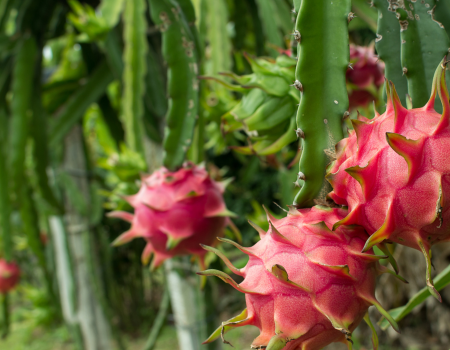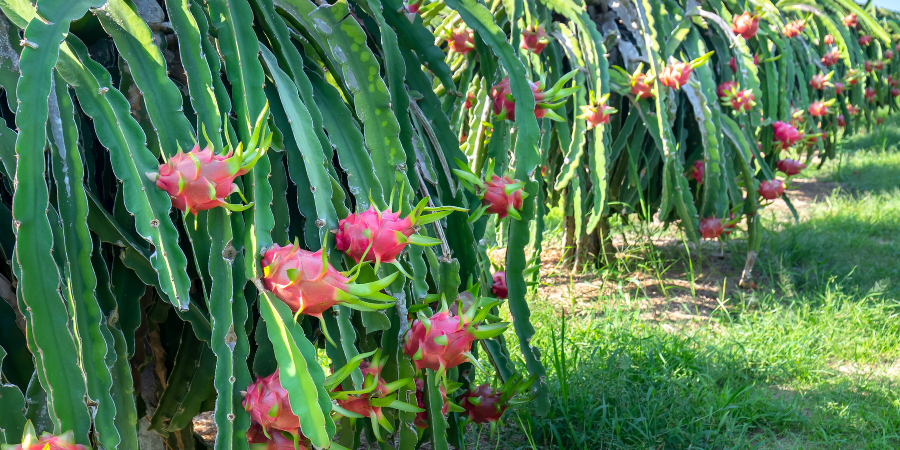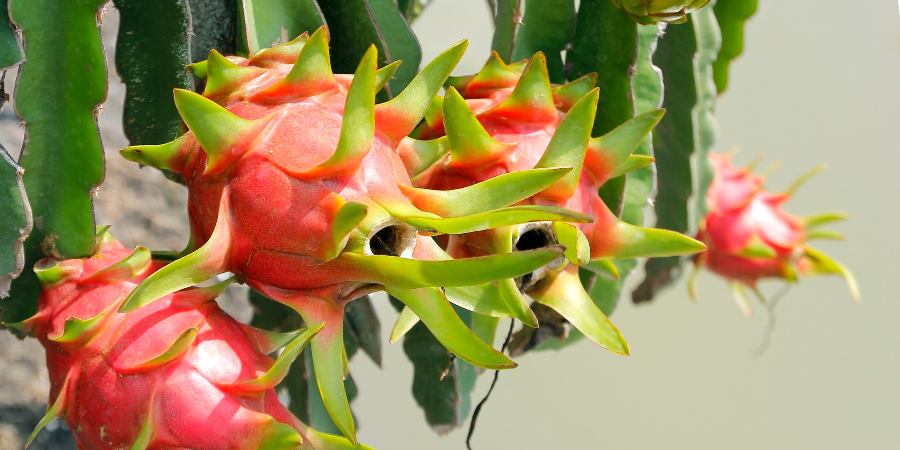Dragon Fruit Tree: The Ultimate Guide

Although we commonly know it as a fruit, the dragon fruit is a cactus. It has pink or yellow scaly skin on the outside and white or red flesh on the inside. The sweet flavor of this fruit resembles a kiwi fruit or pear. Let's learn more about dragon fruit plant care so that you can grow your own dragon fruit tree at home.
Fast Facts for the Dragon Fruit Tree
| Common Name | Pitaya plant, dragon fruit plant, dragon fruit tree |
|---|---|
| Scientific Name | Selenicereus undatus, Hylocereus megalanthus |
| Harvest | October through November |
| Light | 6 to 8 hours of daily sunlight and does well in full sun |
| Water | Need a liter or two of water during summer days, but the watering requirements may decrease in rainy seasons |
| Soil | Need well-draining soil with organic matter and nutrient retention |
| Fertilizer | Should be fertilized three to four times during the growing season, while compost or manure should be applied in summer and spring |
| Pests | Susceptible to attacks by the mealybugs and green plant hopper |
| Diseases | Affected by cactus viral disease, stem canker, and anthracnose |
| Growing Zone | 10 to 11 |
Table of Contents
Everything You Need to Know to Take Care of Dragon Fruit Trees

The dragon fruit tree is an exotic plant that can produce fruit in the first year of growth if you follow the growth requirements. Since the plant does well in tropical or subtropical locations, Zones 10 to 11 are optimal for the plant's growth.
The dragon fruit plant grows in ovular segments connected at thin junctions called joints. Every ovular stem or segment has sharp spines on it and produces aerial roots.
When grown commercially, producers train the dragon fruit plant to grow in the shape of a tree. They use a support along which the stem grows tall. At the top, the plant spills over the support, resembling a palm.
The flowers of dragon fruit plants are large and fragrant. They have white petals and produce red-pink fruits.
It's possible to grow a dragon fruit plant out in the soil or in a pot. If you plan to do the latter, choose a big pot, like a 25-gallon one, so that you don't have to repot the plant once it grows.
Planting
A simple way to grow dragon fruit is to buy the fruit from the grocery store and plant the tiny black seeds. Here's how to plant the dragon fruit tree:
- Select the Site: Since the dragon fruit plant needs a lot of sun, you should grow it in an area that gets at least 6 hours of daily sunlight. Whether you're growing in a pot or the ground, do not select cactus soil. Unlike cactus plants, dragon fruit plants need soil that can retain sufficient moisture.
- Get the Seeds: Take a dragon fruit and cut it in half to get the seeds out. Wet a paper towel and soak the seeds in it for 12 hours.
- Plant: Now, put the seeds on the ground and cover them with a soil layer. The seeds don't have to be too deep in the soil.
- Water: Water the soil to keep it moist. If the soil you've selected gets dry quickly, water it frequently or put plastic wrap on it to retain moisture.
- Transplant: If you've sowed the seeds in a pot indoors, transplant them into larger pots when the plants grow.
- Support: When the plant is about 12 inches tall, it will need some sort of support for proper structure. Since the dragon fruit plant is climbing in nature, it needs a wood stake or trellis to grow up.
Care and Maintenance
Caring for dragon fruit plants isn't very hard if you know the basics. Here are the requirements to grow dragon fruit.
Sun and Temperature
Warm regions are great for growing dragon fruit trees. The plant needs a lot of sun daily, ranging from 6 to 8 hours.
Ideally, the temperature range for the plant should be between 70 and 85°F. If the temperature drops below 55°F, the plant might freeze. Similarly, if the temperature is 100°F or higher, your dragon fruit plant can get burnt.
If your area gets super hot in the summer, you should have arrangements to keep your dragon fruit plant in the shade.
Water and Humidity
Like other plants in the cactus family, the dragon fruit tree also doesn't need a lot of water. Use the soak-and-dry method to water the dragon fruit tree.
In this approach, you only water the plant if the top 1 or 2 inches are fully dry. When the soil is dry, water the plant so extensively that the extra water comes out of the drainage holes in the pot.
However, you don't want to soak the plant in the water fully since it doesn't like being soggy. As a rule of thumb, there shouldn't be a puddle around the soil after you water.
The best time to water the dragon fruit tree is in the morning. It allows the plant to have access to water throughout the day.
Soil
The dragon fruit tree needs well-draining soil that can retain nutrients. You can make this soil mix yourself by mixing 1/3 cactus mix into 2/3 vegetable potting soil. While the cactus soil provides drainage, the vegetable mix contains nutrients.
Although the soil pH doesn't matter much, it's still better to opt for slightly acidic soil. The pH should be between 6 to 7.
Fertilizing
To grow your own dragon fruit cactus, you'll definitely need a nitrogen-rich fertilizer. Use a 6-6-6 NPK ratio fertilizer in the green growth phase of the plant.
When you see flowers, fertilize the plant with an 8-4-12 NPK ratio fertilizer. A date palm fertilizer will work great in this case. Such a fertilizer is rich in potassium and helps the plant flower.
You can also apply a slow-release fertilizer to the plant throughout the growing season. Add 1/4 cup of a balanced fertilizer to the soil every month in the growing season to see good growth. Water it to help it mix properly.
Do not fertilize the dragon fruit plant during winter. Stopping fertilizing will allow the plant to be dormant throughout winter.
Pruning
Pruning a dragon fruit tree is important because the plant can otherwise climb walls and other support objects in your home. However, there's sufficient space between the plant's stem and the support. That's where pests can hide, or moisture can accumulate.
Prune the plant regularly so the stems do not get too long and entangled. Also, remove any dead or broken stems. Here's how to prune the dragon fruit plant:
- Choose which stems you want to prune. Look at the dead, diseased, or drying branches first.
- After removing these limbs, trim back the stems that may be growing inward toward the support rather than along it.
- Cut the parts that are not well-exposed to sunlight and are only creating resource competition. When you remove these branches, the healthy and sun-lit branches won't have to compete for resources, allowing them to flourish.
Propagation
You can propagate a dragon fruit plant using cuttings. All you have to do is remove a segment from the plant and encourage root growth. You'll need the following:
- Gloves
- Soil
- Pot
- Pruners
To start, take your pruners and cut a segment of your dragon fruit tree at the joint. Alternatively, use a section that you pruned off.
Cut the aerial roots of this segment. Also, remove diseased or damaged stems. Take a pair of clippers and cut the segment's bottom in a way that it forms a triangle.
Leave the cutting for about 3 days to dry. When you see scabs covering the cutting, it's time to plant. Make sure you plant the cutting side in the ground. You can mark it with a marker when you take the cutting.
Fill a pot with the right soil mix and put the cutting in it with the cutting side in the soil. The stem will not need any support to keep standing, but you can still use a stake to give it some support.
Water the soil and put the pot in the shade. In a few weeks, you will see new growth from the edges or the top.
Training
The dragon fruit tree needs to be trained to grow along the support. Otherwise, it will droop.
Choose a sturdy support that gives the plant structure. Don't use a smooth surface since the plant doesn't like to climb up such supports. Here's how to train the plant:
- Take the plant out of the container and move your fingers through its roots to loosen them up.
- Water the soil and insert a stake into the ground.
- Place the dragon fruit tree in its new location and tie it to the stake using soft materials like yarn or ribbon.
- Securely fasten the plant against the stake with ties spaced 2 inches apart.
- Prune any lateral shoots from the stem, and always keep an eye on how it's growing.
When initially tied, the dragon fruit plant will look slightly messy since the whole stake will not be covered. But let the plant grow so that it fills up the whole area. When new growth arises, tie it to the support too.
After some time, aerial roots will grow from the plant and cling to the stake. The dragon fruit tree should be trained until all the aerial roots are attached and the plant is held up by its own roots.
Harvesting and Storing
Ripe dragon fruits are fully covered. The only thing you can see are spiky tips. When you press the flesh with your hand, it will be slightly soft.
Harvesting
When the fruit is ready for harvest in October or November, harvest it with clippers. Sanitize the clippers before using them on the plant.
Clip the fruit from the tree, cutting close to the fruit. Doing so will help ensure the stem doesn't get damaged.
You can eat the dragon fruit right off the plant. Or you can put it in the refrigerator for better taste. To eat the fruit, cut it in half. Scoop the inner flesh with a spoon. Or you can peel its skin off and cut the fruit into pieces.
Storing
To store the fruit, keep it in the fridge. You can keep it as it is or put it in a container to keep it fresh. Keep in mind that dragon fruits absorb the odor of other edibles in your fridge. So, it's better to keep the fruit covered.
If you've cut the fruit, it will only stay fresh for about two days. The flesh becomes mushy and brown after some time.
The best way to store dragon fruits for a long time is to freeze them. Cut slices of the fruit and put them in the freezer. Put the frozen dragon fruit pieces into airtight containers.
Did you know? Dragon fruit has a high concentration of lycopene, which might lower the risk of cancer and heart disease.
Common Issues With Dragon Fruit Trees

Plants that produce edible fruits are susceptible to more problems than other plants since they grow fruit too. The same is true for dragon fruit trees too. Here are some common issues you should be familiar with.
Growing Problems
Dragon fruit trees can flower in their first year. However, not everyone can achieve this. Here's a tip that can help.
When the growing season is ending, put a nitrogen-rich fertilizer in the soil and water to let it seep through. Also, apply a liquid fertilizer rich in potassium and phosphorus.
Then, prune the stems and shoots of the plant that don't get enough light. The key is to ensure that stems that get enough sunlight are given the opportunity to flower. When you remove the other shoots, these stems will be able to use more resources and nutrients to grow flowers and fruit.
Another growing problem dragon fruit plants can face is sunscald. If exposed to harsh sunlight, the plant can burn. There's no way to bring the burnt sections of the plant back to life.
If this happens, you can remove the burnt parts of the plant. Apply neem oil to the blisters to let them heal. Also, move the plant from its current place to prevent future burns.
Pests
Pests are a notable concern in growing dragon fruit plants. Here are some pests to keep an eye out for.
Scale Insects
Scale insects may be of two types: armored and soft. Here's how to identify soft scale insects:
- 1/8 to 1/4 inch in length
- Feed mainly on shrubs and trees
- Excrete sap called honeydew
Honeydew is even more problematic since it attracts wasps, flies, and ants. However, the presence of honeydew doesn't automatically indicate scale insects. Some other pests, like aphids, also excrete honeydew.
To identify armored scale insects, look for these characteristics:
- 1/16 to 1/8 inch in length and elongate to oval in shape
- Hard to identify since their color is the same as the host tree's bark
Compared to soft insects, armored scale insects damage the plant more. They feed on the dragon fruit plant tissue, causing cell death. When the vascular tissue breaks, nutrients, and water cannot be transported through the plant, resulting in the branches dying.
To manage scale insects, biological control doesn't suffice. When the number of scale insects increases, you need to use pesticides.
Start with low-impact pesticides, such as horticultural oils and insecticidal soaps. These pesticides impact the environment minimally and can help manage scale insects in smaller numbers.
You can also spray insect growth regulators. These pesticides affect the development of scale insects and prevent them from growing into full adults. However, these regulators do not work on adults. You'll need to use systemic pesticides instead:
- Imidacloprid: It can be applied around the dragon fruit tree trunk. The pesticide helps manage soft scales.
- Dinotefuran: It comes in the form of granules and affects armored and soft scales.
Mealybugs
Mealybugs are smaller oval insects that can affect all parts of the tree, even the roots. They may be 1/20 to 1/5 inch in length and are covered with a cottony wax.
Although chemical control is available for the pest, it's a bit difficult due to the cottony wax that covers the insect. Apply insect growth regulators to keep larvae from developing into adults. Consult a specialist in case of a large infestation.
Fruit Flies
Fruit flies can lay eggs on dragon fruits, resulting in bacterial influence. You should wash the fruits properly before eating them.
Set traps to capture adult fruit flies. Fill a jar with apple cider vinegar, liquid soap, and sugar. Place the jars near the dragon fruits to attract the adult fruit flies.
Alternatively, you can fill a cup of water and add sugar, vinegar, overripe fruit, and dish soap to it. Put a paper cone on top of this cup. The flies will come to this cup for the sugar. As they enter, the dish soap will trap them, allowing the vinegar to kill them.
Diseases
Diseases affecting these cactus plants result in stunted or poor fruit production. Affected trees may not bear fruit at all. The following diseases affect the dragon fruit plant.
Stem Canker
Neoscytalidium dimidiatum is a fungus that causes stem cankers on dragon fruit plants. The disease is characterized by a reddish-brown lesion at the base of the plant's stem. It may also cause dieback or wilting of branches, leading to full tree death if left untreated.
One way to manage the infection is to prune the affected stems. Sanitize your pruning tools before using them on healthy stems or plants. You can also use fungicides if the infection is too widespread.
Root Rot
Root rot is a result of overwatering. It can kill your dragon fruit plant if you do not remediate the situation soon enough. To prevent root rot, choose soil with proper drainage. If you're growing the plant in a pot, make sure it has drainage holes.
If you notice the signs of root rot, take your plant out of the ground or the container and cut the affected roots. Do not repot the plant immediately, though. Let it dry for a while, and then repot it in new soil.
Fruit Rot
A plant affected by fruit rot will have mushy lesions on dragon fruits. You will notice the fruit turning brown and yellow. The infection starts as lesions, which eventually convert to rot, killing the whole plant.
It's not easy to treat fruit rot, so you should focus on prevention instead. The fungus causing fruit rot loves wet and warm conditions. It's important to keep the soil dry and remove diseased fruits from the plant.
Also, do not over fertilize the plant, as too much nitrogen can cause rot. If you see thinning fruit, remove it from the plant. Keep fruit-feeding insects, like the oriental moths and twig borers, at bay.
FAQs
Before you go...
Now that you know how to take care of coffee trees, you might be interested in some other plant care guides. Be sure to check out our other guide on the pluot tree so you can learn more about unique things to garden...
Related Articles:

Christina Hernandez
Christina has done most of her research on environmental science but recently has changed her focus towards sustainable forestry. She has a passion for the outdoors and wants to spread that passion to the world.
Join our community!
Join to receive guides, insights, and the latest gardening deals!
